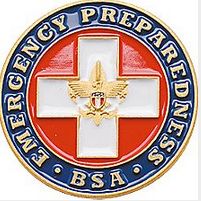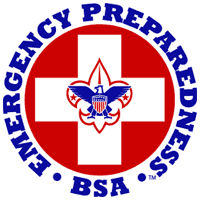This award was discontinued on December 31, 2020.
Those who are in the process of earning the award have until December 31, 2021 to complete the requirements and earn the award.
Note: We have eliminated references to Varsity Scouting in the text below (which appear in the requirements posted on Scouting.org), since that program was discontinues in 2018, and we have added references to Sea Scouting since it is now separate from Venturing.
From its beginning, the Scouting movement has taught young people to do their best, to do their duty to God and country, to help others, and to prepare themselves physically, mentally, and morally to meet these goals. The basic aims of Scouting include teaching young people to take care of themselves, to be helpful to others, and to develop courage, self-reliance, and the ability to be ready to serve in an emergency.
The Emergency Preparedness BSA Award, first introduced in 2003 and updated in 2014, was designed with the aims mentioned above in mind. The award has been earned by tens of thousands of Scouts and Scouters individually, with their unit, or at a large event such as a jamboree. By developing these lifelong skills, Scouts have been instrumental in helping their communities recover from emergencies.
When an emergency does occur, it can affect every BSA youth and adult member in the immediate area. Earning the award teaches participants to respond first, as an individual; second, as a member of a family; and third, as a member of a Scouting unit serving their neighborhood and community. This award will allow all Scouts and Scouters to become informed, be prepared, and act promptly and appropriately in the event of emergencies, whether they are natural or man-made.
Scouts and adult leaders can earn the individual Emergency Preparedness Award. Meanwhile, units, districts, and councils can work toward earning the bronze, silver, or gold achievement level. The awards are available at local Scout shops once specific requirements for each rank or achievement level have been met.
When a member has fulfilled the requirements, a completed application is submitted to the council. Upon approval, an Emergency Preparedness pin is awarded. The pin may be worn on civilian clothing or on the uniform, centered on the left pocket flap. The award may be earned more than once; for instance, as a young person advances through the ranks and is capable of more complex preparedness activities, but only one pin may be worn.
All emergency activities carried out by Scouting units must be appropriate for the ages and abilities of the young people involved. Units should participate only under the supervision of their own leaders, and plans for unit help must be coordinated with community agencies responsible for disaster preparedness.
You can download the application here.
Individual Emergency Preparedness Award Requirements
Separate age appropriate requirements have been developed for Tiger Cubs, Wolf Cub Scouts, Bear Cub Scouts, Webelos Scouts, Boy Scouts, Venturers and Sea Scouts, Unit Volunteer Scouters, and District/Council Volunteer Scouters.
Tiger Cub Scout Requirements
- Cover a family fire plan and drill, and what to do if separated from the family.
- Discuss a family emergency plan with the family.
- Create, plan, and practice summoning help during an emergency.
- Take a nationally recognized first-aid course geared toward children such as American Red Cross First Aid for Children Today (FACT).
- Join a safe kids program such as McGruff Child Identification, Internet Safety, or Safety at Home.
- Show and tell your family household what you have learned about preparing for emergencies.
Wolf Cub Scout Requirements
- Create a checklist to keep your home safe.
- Discuss a family emergency plan with the family.
- Create, plan, and practice summoning help during an emergency.
- Learn emergency skills and care for choking, wounds, nosebleeds, falls, and animal bites. The emergency skills should include responses for fire safety, poisoning, water accidents, substance abuse, and more.
- Join a safe kids program such as the McGruff Child Identification program. Put on a training program for your family or den on stranger awareness, Internet safety, or safety at home.
- Make a presentation to your family on what you have learned about preparing for emergencies.
Bear Cub Scout Requirements
- Create, plan, and practice summoning help during an emergency.
- Learn how to shut off utilities to your home in an emergency.
- Learn simple rescue techniques.
- Learn emergency skills and care for choking, wounds, nosebleeds, falls, and animal bites. The emergency skills should include responses for fire safety, poisoning, water accidents, substance abuse, and more.
- Put together a family emergency kit for use in the home.
- Organize a safe kids program such as the McGruff Child Identification program. Put on a training program for your family or den on stranger awareness, Internet safety, or safety at home.
- Make a small display or give a presentation for your family or den on what you have learned about preparing for emergencies.
Webelos Scout Requirements
- Learn rescue techniques.
- Build a family emergency kit, with an adult family member participating in the project.
- Take a first-aid course.
- Learn to survive extreme weather situations.
- Learn about stranger awareness, Internet safety, or safety at home.
- Give a presentation to your den on preparing for emergencies.
Boy Scout Requirements
- Participate in creating an emergency plan for your home and for your troop's Scouting activities. Be sure you know the details of both emergency plans.
- Earn the First Aid or Emergency Preparedness merit badge.
- With your troop, including its adult leaders, participate in emergency preparedness training conducted by community emergency preparedness agencies.
- Complete IS-100.b, Introduction to Incident Command System (see http://training.fema.gov/IS/NIMS.asp ).
Venturer and Sea Scout Requirements
- Complete a nationally recognized first-aid course or complete a nationally recognized Wilderness First Aid course.
- With your crew, including its adult leaders, participate in emergency preparedness training coordinated by community emergency preparedness agencies.
- Complete IS-100.b, Introduction to Incident Command System (see http://training.fema.gov/IS/NIMS.asp ).
- Plan and execute an emergency preparedness training event for a pack or troop.
Unit Volunteer Scouter Requirements
This award is available to all registered Scouters who serve a unit, including all leaders and committee members.
Do any three of the following:
- Provide input to develop or improve an emergency preparedness program plan and kit for your home and be sure all family members know the plan.
- Participate actively in preparing an emergency action plan for your Scouting unit meeting place. (This includes all locations where you might have a meeting.)
- Put together a unit emergency kit to be kept at your unit meeting location. (This includes all locations where you might have a meeting.)
- Take a basic first-aid/CPR/AED course.
- Participate as an active volunteer in a community agency responsible for disaster preparedness.
- Complete IS-100.b, Introduction to Incident Command System (see http://training.fema.gov/IS/NIMS.asp ).
Council/District Volunteer Scouter Requirements
Do any three of the following:
- Provide input to develop or improve an emergency preparedness program plan and kit for your council or district.
- Take a basic first-aid/CPR/AED course.
- Participate as an active volunteer in a community agency responsible for emergency disaster preparedness.
- Participate actively in developing an emergency preparedness program for a council or district activity such as a camporee or Scouting show.
- Complete IS-100.b, Introduction to Incident Command System (see http://training.fema.gov/IS/NIMS.asp ).
District-, Council-, and Unit-Level Achievement
District- and Council-Level Achievement
- Bronze Level: If completed three of the above and if 30 percent of your traditional units have achieved the award.
- Silver Level: If completed three of the above and if 40 percent of your traditional units have achieved the award.
- Gold Level: If completed three of the above and if 50 percent of your traditional units have achieved the award.
Unit-Level Achievement
Achieve the mandatory requirements below, and:
- Bronze Level: If 30 percent of your youth and adult members have achieved the award.
- Silver Level: If 40 percent of your youth and adult members have achieved the award.
- Gold Level: If 50 percent of your youth and adult members have achieved the award.
Mandatory Unit Requirements
- The unit members conduct a check or create a unit and personal first-aid kit.
- The unit members conduct a safety check of their meeting place using the checklist in the Guide to Safe Scouting.
- The Cubmaster, Scoutmaster, Coach, or Advisor and the assistant Cubmasters, Scoutmasters, Coaches, or Advisors, and the unit committee chair have in their possession and have read the most current Guide to Safe Scouting.
- The unit members create an emergency action plan for unit use during regular meetings, tours, and activities. See https://filestore.scouting.org/filestore/doc/680-029.doc .
- Greater than 40 percent of registered adults are trained in Safety Afloat and Safe Swim Defense.
- Greater than 40 percent of registered members, including at least one adult, are trained in first aid and CPR/AED by a recognized agency such as the Emergency Care and Safety Institute, the American Red Cross, or the American Heart Association.
- Greater than 40 percent of unit members completed the SCOUTStrong fitness program or earned the Quest Award.
- Mandatory for troops only: All youth members with a driving permit or driver’s license have earned the Traffic Safety merit badge.
- Mandatory for troops only: Greater than 40 percent of registered Scouts have earned the First Aid merit badge and are certified in CPR/Wilderness First Aid.
- Mandatory for Venturing crews and Sea Scout ships only: All youth with a driving permit or driver’s license have taken Venturing Out: Keys to Safe Driving online or attended a group presentation of the Risk Zone: Transporting Scouts Safely. Smart Choices: driving, drugs, and alcohol is a presentation discussing the dangers of drinking and Driving. Download the presentation here . The speaker’s notes can be printed from the presentation, or may be downloaded separately as a PDF.
- Mandatory for Venturing crews and Sea Scout ships only: Greater than 40 percent of registered crew or ship members are trained in CPR/AED by a nationally recognized agency such as the Emergency Care and Safety Institute, the American Red Cross, or the American Heart Association.
- Mandatory for troops/Venturing crews/Sea Scout ships only: Greater than 40 percent of registered Scouts and adults have completed IS-100.b, Introduction to Incident Command System (see http://training.fema.gov/IS/NIMS.asp ).
Do one of the following:
- The unit conducts a safety promotion with the community about emergency preparedness and/or readiness.
- Identify a unit’s risk management or health and safety officer. Attach a copy of the duties and responsibilities assigned to this position to the application.
Program Items
Individual or bronze, silver, or gold awards are available at Scout shops once requirements for the award have been met. The pin may be worn on civilian clothing or on the uniform, centered on the left pocket flap.
- Emergency Preparedness BSA pin, No. 00540 (civilian wear/uniform, centered on left pocket flap). Awarded when requirements are met. Only one pin may be worn.
- Emergency Preparedness BSA pin bronze, No. 620353
- Emergency Preparedness BSA pin silver, No. 620354
- Emergency Preparedness BSA pin gold, No. 620355
- Emergency Preparedness BSA information pocket card, No. 32185
- Emergency Preparedness BSA support recognition certificate (8'' x 10"), No. 32186
 |
 |
|||
| 00540 |
|
Source: scouting.org








